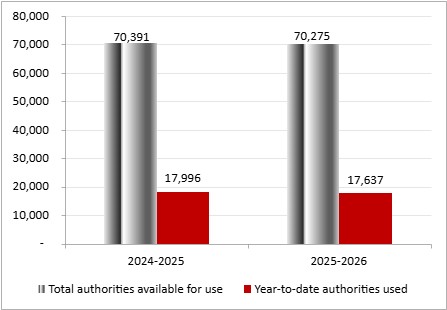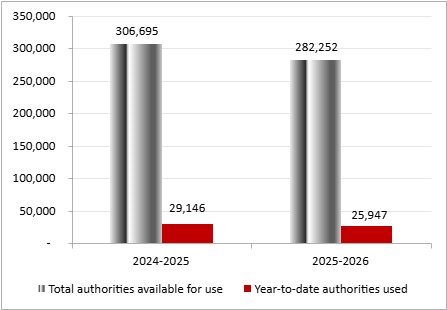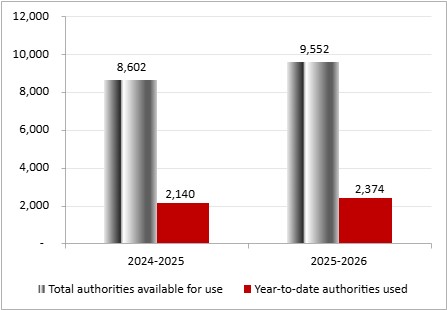Atlantic Canada Opportunities Agency - Quarterly Financial Report for the quarter ended June 30, 2025
About this publication
© His Majesty the King in Right of Canada, as represented by the
Minister of Justice and Attorney General of Canada and Minister
responsible for the Atlantic Canada Opportunities Agency, 2025.
Catalogue No. AC3-1E-PDF
ISSN 2817-3694
Statement Outlining Results, Risks and Significant Changes in Operations, Personnel and Programs
INTRODUCTION
This quarterly financial report should be read in conjunction with the Main Estimates. It has been prepared by management as required by section 65.1 of the Financial Administration Act (FAA) and in the form and manner prescribed by the Treasury Board. This quarterly report has not been subjected to an external audit or review.
A summary description of the Atlantic Canada Opportunities Agency (ACOA) program activities can be found in Part II of the 2025-2026 Main Estimates.
Basis of presentation
This quarterly financial report has been prepared by management using an expenditure basis of accounting. The accompanying Statement of Authorities is consistent with the Main Estimates for the 2025-2026 fiscal year and includes ACOA’s total authorities available for use as granted by Parliament and those used by the Agency during this quarter. Authorities available for use are given in the form of annually approved limits through appropriation acts or through legislation in the form of statutory authorities for specific purposes.
The authority of Parliament is required before monies can be spent by the Government.
When Parliament is dissolved for the purposes of a general election, section 30 of the FAA authorizes, under certain conditions, the preparation of special warrants to be signed by the Governor General authorizing payments to be made from the Consolidated Revenue Fund. Special warrants are deemed to be an appropriation for the fiscal year in which they are issued.
Special warrants issued during the first quarter of 2025-2026 were included in the total appropriations in the Main Estimates for 2025-2026.
As part of the departmental results reporting process, the Agency prepares its annual departmental financial statements on a full accrual basis in accordance with Treasury Board accounting policies. However, the spending authorities voted by Parliament remain on an expenditure basis of accounting.
ACOA financial structure
ACOA manages its expenditures under two votes:
- Vote 1 – Net operating expenditures includes the Agency’s authorities related to personnel costs (e.g., salaries) and operation and maintenance expenditures (e.g., travel)
- Vote 5 – Grants and contributions includes authorities related to transfer payments
Costs under Statutory Authorities, which represent payments made under legislation approved previously by Parliament and which are not part of the annual appropriation bills, include such items as the employer’s share of the employee benefits plan and other minor items.
HIGHLIGHTS OF FISCAL QUARTER AND FISCAL YEAR-TO-DATE RESULTS
This section highlights significant changes to the fiscal quarter results as of June 30, 2025.
Statement of authorities: Vote 1 – Net Operating Expenditures
Total authorities available for fiscal year 2025-2026 are $70.3 million, with no significant variance compared to $70.4 million as of June 30, 2024.
Vote 1 authorities used year-to-date were $17.6 million at the end of the first quarter this fiscal year, with no significant variance compared to $18.0 million as of June 30, 2024.
Graph 1 illustrates the total authorities available for use for the year as well as the amount used year-to-date at quarter-end.
Graph 1: Comparison of Net Budgetary Authorities and Expenditures for Vote 1 as of June 30, 2024-2025 and 2025-2026.
(in thousands of dollars)

Graph 1 - Long description
For the year ending March 31, 2025, total authorities available for use for Vote 1 is $70,391,000, while year to date authorities used for Vote 1 is $17,996,000.
For the year ending March 31, 2026, total authorities available for use for Vote 1 is $70,275,000, while year to date authorities used for Vote 1 is $17,637,000.
Statement of authorities: Vote 5 – Grants and Contributions
Total authorities available for use for the year ending March 31, 2026, amount to $282.3 million, a decrease of $24.4 million compared to the $306.7 million available for use as of June 30, 2024. The decrease of $24.4 million, or 8%, is explained below.
A total decrease of $39.6 million in Vote 5 authorities available for use related to:
- a $31.0 million decrease in temporary funding for the Hurricane Fiona Recovery Fund, reprofiled from fiscal year 2023-2024 to fiscal year 2024-2025
- an $8.6 million decrease in temporary funding for the Canada Coal Transition Initiative – Infrastructure Fund
This decrease is offset by a total increase of $15.2 million in Vote 5 authorities available for use related to:
- a $5.5 million increase in temporary funding for the renewal of top-up funding for the Regional Economic Growth through Innovation program
- a $4.3 million increase related to a reprofile of funds as a result of project/contracting delays
- a $2.8 million increase in temporary funding for the Regional Artificial Intelligence Initiative
- a $1.6 million increase in temporary funding for the BioAccelerator Project
- a $0.6 million increase in temporary funding in support of a renewed Food Policy for Canada
- $0.4 million in other adjustments
Vote 5 authorities used decreased from $29.1 million last fiscal year to $25.9 million this fiscal year. This $3.2 million decrease in authorities used, or 11%, is mainly due to the timing of contribution payments compared to the previous fiscal year.
Graph 2 illustrates the total authorities available for use for the year as well as the amount used year-to-date at quarter-end.
Graph 2: Comparison of Net Budgetary Authorities and Expenditures for Vote 5 as of June 30, 2024-2025 and 2025-2026.
(in thousands of dollars)

Graph 2 - Long description
For the year ending March 31, 2025, total authorities available for use for Vote 5 is $306,695,0000, while year to date authorities used for Vote 5 is $29,146,000.
For the year ending March 31, 2026, total authorities available for use for Vote 5 is $282,252,000, while year to date authorities used for Vote 5 is $25,947,000.
Statement of authorities: budgetary statutory authorities
Budgetary statutory authorities available for use for the year ending March 31, 2026, have increased by $0.9 million, or 11%, to $9.5 million compared to the previous fiscal year at the same time.
Budgetary statutory authorities used year-to-date were $2.4 million at the end of the first quarter this fiscal year, with no significant variance compared to $2.1 million as of June 30, 2024.
Graph 3 illustrates the total authorities available for use for the year as well as the amount used year-to-date at quarter-end.
Graph 3: Comparison of Net Budgetary Authorities and Expenditures for Statutory Authorities as of June 30, 2024-2025 and 2025-2026
(in thousands of dollars)

Graph 3 - Long description
For the year ending March 31, 2025, total authorities available for use for Statutory authorities is $8,602,000 of dollars, while year to date authorities used for Statutory authorities is $2,140,000.
For the year ending March 31, 2026, total authorities available for use for Statutory authorities is $9,552,000, while year to date authorities used for Statutory authorities is $2,374,000.
Statement of the Agency’s budgetary expenditures by standard object
The Agency’s budgetary expenditures by Standard Object for the quarter ended June 30, 2025, were $46.0 million, which reflects a decrease of $3.3 million, or 6.7%, from the $49.3 million in overall expenditures for the quarter ended June 30, 2024.
Risks and uncertainties
ACOA’s integrated risk profile identifies key factors that could affect the Agency’s ability to fulfill its mandate. These risks reflect both external pressures and internal challenges within ACOA’s complex operating landscape.
Externally, ACOA faces two primary risks:
- Economic uncertainty: The Agency’s economic development programming may be influenced by external factors – global market shifts, demographic trends, or policy changes – that contribute to uncertainty in Atlantic Canada’s economic growth
- Stakeholder capacity: The ability of ACOA’s stakeholders – including other governments, partners, communities and clients – to identify, develop and implement strategic projects may be limited. This could constrain the achievement of ACOA’s program objectives
To address these challenges, ACOA will continue to leverage the flexibility of its programs, including emergency funding; strengthen its advocacy role to support regional priorities; and apply integrated planning to adapt to evolving economic conditions and stakeholder needs. The Agency will also conduct targeted analyses of regional economic issues and collaborate with stakeholders to build capacity among clients and communities – supporting progress toward key federal priorities.
Complementing its external risk mitigation efforts, ACOA maintains strong internal controls to safeguard its operations and financial integrity. These include:
- regular assessments of entity-level controls, general computer controls, and key business processes such as payments on grants and contributions, operating expenses, and accounts receivable
- a structured budgetary and allocation framework supported by automated financial controls
- periodic forecasting and financial analysis to ensure effective resource management
To further strengthen its risk management practices, the Agency will continue annual processes such as the Compliance Risk Process; collaborate with other regional development agencies to monitor and respond to emerging risks; and enhance risk identification and assessment across all levels of operations.
Significant changes in relation to operations, personnel and programs
On March 23, 2025, the Parliament of Canada was dissolved, initiating the caretaker convention. During a period in which Parliament is dissolved for a general election, the FAA permits the Governor General to authorize spending through special warrants. Special warrants were issued covering the period from April 1 to June 29, 2025, ensuring that government operations could continue until the Main Estimates were approved by Parliament.
In addition, the following changes occurred during the first quarter:
- The Prime Minister appointed the Honourable Sean Fraser as Minister of Justice and Attorney General of Canada and Minister responsible for the Atlantic Canada Opportunities Agency, effective May 13, 2025.
- On June 24, 2025, the President announced the appointment of Chuck Maillet as Vice-President, Policy, Programs and Communications, and Janine Fraser as Vice-President, Nova Scotia.
Approval by senior officials
Approved by:
Laura Lee Langley
Deputy Head
Moncton, Canada
Date: August 29, 2025
Lyne Lirette-LeBlanc
Acting Chief Financial Officer
Moncton, Canada
Date: August 27, 2025
| Authorities | Total available for use for the year ending March 31, 2026* |
Used during the quarter ended June 30, 2025 |
Year-to-date used at quarter-end |
|---|---|---|---|
| Vote 1 – Net operating expenditures | 70,275 | 17,637 | 17,637 |
| Vote 5 – Grants and contributions | 282,252 | 25,947 | 25,947 |
| Budgetary statutory authorities | 9,552 | 2,374 | 2,374 |
| Total authorities | 362,079 | 45,958 | 45,958 |
| Authorities | Total available for use for the year ending March 31, 2025* |
Used during the quarter ended June 30, 2024 |
Year-to-date used at quarter-end |
|---|---|---|---|
| Vote 1 – Net operating expenditures | 70,391 | 17,996 | 17,996 |
| Vote 5 – Grants and contributions | 306,695 | 29,146 | 29,146 |
| Budgetary statutory authorities | 8,602 | 2,140 | 2,140 |
| Total authorities | 385,688 | 49,282 | 49,282 |
*Includes only Authorities available for use and granted by Parliament at quarter-end.
| Expenditures | Planned expenditures for the year ending March 31, 2026* |
Expended during the quarter ended June 30, 2025 |
Year-to-date expended at quarter-end |
|---|---|---|---|
| Personnel | 71,572 | 18,326 | 18,326 |
| Transportation and communications | 1,379 | 250 | 250 |
| Information | 896 | 140 | 140 |
| Professional and special services | 2,116 | 257 | 257 |
| Rentals | 1,731 | 755 | 755 |
| Repair and maintenance | 87 | 7 | 7 |
| Utilities, materials and supplies | 126 | 8 | 8 |
| Acquisition of machinery and equipment | 918 | 4 | 4 |
| Transfer payments | 282,252 | 25,947 | 25,947 |
| Other subsidies and payments | 1,002 | 264 | 264 |
| Total net budgetary expenditures | 362,079 | 45,958 | 45,958 |
| Expenditures | Planned expenditures for the year ending March 31, 2025* |
Expended during the quarter ended June 30, 2024 |
Year-to-date expended at quarter-end |
|---|---|---|---|
| Personnel | 70,570 | 17,804 | 17,804 |
| Transportation and communications | 1,399 | 417 | 417 |
| Information | 542 | 170 | 170 |
| Professional and special services | 2,688 | 335 | 335 |
| Rentals | 1,711 | 793 | 793 |
| Repair and maintenance | 96 | 11 | 11 |
| Utilities, materials and supplies | 219 | 11 | 11 |
| Acquisition of machinery and equipment | 692 | 228 | 228 |
| Transfer payments | 306,695 | 29,146 | 29,146 |
| Other subsidies and payments | 1,076 | 367 | 367 |
| Total net budgetary expenditures | 385,688 | 49,282 | 49,282 |
*Includes only Authorities available for use and granted by Parliament at quarter-end.